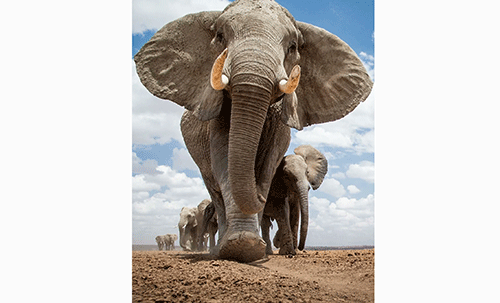As southern Africa countries continue to wage war against the decades-long trade ban to sell millions worth of ivory stockpiles, a new setback has hit their struggle, as a near total ban on the import, export and dealing of items containing ivory came into force in Britain yesterday.
Namibia recently said if communities living with elephants and other wildlife do not benefit from it, the situation may trigger poaching or just random shooting at these animals. However, the UK’s Ivory Act is one of the toughest bans on ivory sales in the world, with some of the strongest enforcement measures. Those found guilty of breaching the ban will face tough new penalties, including an unlimited fine or up to five years in jail.
Animal welfare minister Lord Goldsmith said: “The world-leading Ivory Act coming into force represents a landmark moment in securing the survival of elephants across the globe for future generations.
“Thousands of elephants are unnecessarily and cruelly targeted for their ivory every year for financial gain. As one of the toughest bans of its kind, we are sending a clear message; the commercial trade of elephant ivory is totally unacceptable. In a submission to the first African Elephant Conference in Hwange, Zimbabwe, Namibia’s tourism deputy minister Heather Sibungo said external parties should not have the liberty to control and sensor the utilisation of African wildlife.
“The African wildlife is ours, as Africans, and it is available at our disposal for use sustainably to our benefits and that of our communities for better development, compensation and sanitation,” she said.
“We have protected these animals for many years, and we’ll continue to sustainably do so.” At the moment, these countries cannot ulitise these animals commercially for their stockpiled ivory, due to the 1989 CITES ban on ivory trade.
CITES is an international agreement between states. Its aim at ensuring that international trade in wild animals and plants does not threaten the survival of the species. Two one-off sales of ivory were allowed since the 1989 ban under CITES.
In 2019, Namibia, Botswana and Zimbabwe asked for the right to sell ivory acquired through natural deaths, confiscations and culling.
But that demand was rejected by a CITES meeting in Geneva.
Sibungo called on African countries to speak one voice in ivory and wildlife trade to directly benefit communities in co-existence and taking care of the wildlife. She further called on these countries to involve their communities to participate in quota settings for the utilisation of elephants and other wildlife species. The conference was held from 23 to 26 May 2022 in the Hwange National Park, Zimbabwe.
Hwange National Park houses the highest elephant population in Zimbabwe. Namibia is especially famed for its now thriving population of desert-adapted elephants living in Damaraland and the Kunene region.
Namibia’s conservation drive saw its elephant population increase from around an estimated 7 500 in 1995 to 24 000 in 2019, according to government figures. Numbers are approximate since elephants are no respecters of a park or even national boundaries, and casually roam through neighbouring territories.
Zimbabwe, with representatives of 14 other southern Africa countries, Namibia included, gathered in a bid to develop a new management strategy and promote the lifting of a ban on ivory trade.
The southern Africa countries at the summit cited a need to derive economic value from thriving elephant herds and management issues.
The African Elephant Conference drafted a Declaration to lobby at CITES for a better trade deal in ivory and wildlife in Africa. However, only five countries signed the conference declaration and the summit failed to come up with a continent-wide consensus that could be taken to the CITES (COP19) meeting in Panama in November.
In the meantime, Namibia continues to auction some of its jumbos in an attempt to strike a balance between the conservation of elephants and management of the risks they pose when they encroach onto land used by humans, but conservationists have questioned the government’s claims of human-elephant conflict. In addition to the impact of the ban on ivory trade on states’ finances and the cohabitation between wildlife and villagers, the management of elephant herds was another pressing issue of the African Elephant summit.
Southern African countries are home to approximately 293 000 or 70% of Africa’s elephant population, and Zimbabwe gathers the world’s largest elephant population.
Certain countries with large elephant herds, like Zimbabwe and Botswana, insist they are ill equipped to protect them and deal with poachers without the money from ivory sales.
Other African countries, such as Kenya, insist that all ivory sales should be banned to discourage any international ivory trade. Last week, Zimbabwe asked European countries for support in selling its US$600 million stockpiles.
But the plea did not immediately garner support. Last year, environment minister Pohamba Shifeta announced that Namibia currently has an ivory stockpile of over N$1 billion.
The current size of Namibia’s ivory stockpile is approximately more than 69 391.71kg.
In 2019, President Hage Geingob expressed concern over the cost and security implications of holding large ivory stocks and has reiterated the country’s stance towards the legal international trade of ivory, from which proceeds would be utilised to support elephant conservation and rural conservation programmes.
Namibia has over the years been vocal in its stance to dispose of its stockpiles of rhino and elephant products on international legal markets.
– anakale@nepc.com.na


